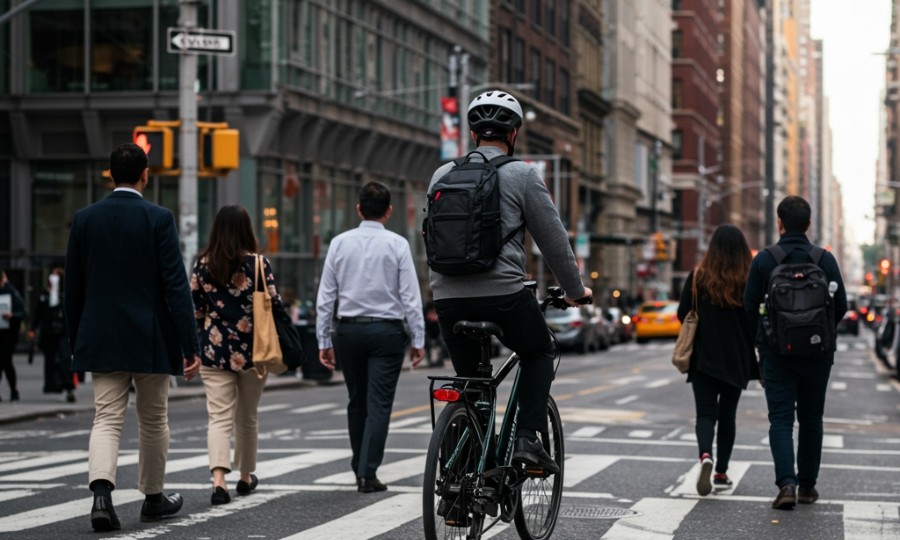
Ever felt that sudden rush of air as an electric bike silently whizzes past you on a busy New York City street, leaving you a bit startled? You’re not alone. E-bikes have undeniably revolutionized urban mobility, offering unparalleled convenience for commuters and, crucially, a lifeline for countless delivery workers who keep our city moving. But here’s the thing: this incredible surge in popularity isn’t without its challenges, especially when it comes to pedestrian safety on our famously crowded sidewalks and crosswalks. We’re grappling with a complex dilemma, aren’t we? It’s about balancing the undeniable benefits of e-mobility with the very real need to keep our streets safe for everyone.
Recent data, as reported by the NYPD and NYC DOT, paints a clear picture: e-bike accidents are on the rise, and unfortunately, pedestrians often bear the brunt. This isn’t just about statistics; it’s about real people, real injuries, and a growing concern among New Yorkers navigating their daily lives. So, how do we move forward? Let’s dive into what’s happening on the ground, what the city is doing, and what we all can do to foster safer streets.
The E-Bike Boom: A New Rhythm for NYC Streets
There’s no denying the appeal of electric bikes. They offer a quicker, often more affordable, and environmentally friendlier way to get around our sprawling metropolis. For many, particularly the dedicated individuals in the food delivery sector, an e-bike isn’t just a convenience; it’s their livelihood. It allows them to cover more ground, faster, through areas that might be less accessible by traditional bicycle or public transit.
However, this efficiency comes with a trade-off. Unlike traditional bicycles, e-bikes can reach higher speeds with less effort, and their electric motors make them remarkably quiet. This combination can catch pedestrians off guard, especially in high-traffic areas where people expect to hear approaching vehicles or bikes. You might be thinking, “Well, aren’t there rules?” And yes, there are. But enforcement, particularly on crowded streets and sometimes against the sheer volume of riders, remains a significant hurdle. In my experience, seeing an e-bike rider deftly weave through traffic or, regrettably, occasionally on a sidewalk, isn’t an uncommon sight.
Unpacking the Numbers: The Surge in Pedestrian Injuries
Let’s talk about the impact. The New York City Police Department’s data has shown a concerning trend: a notable increase in crashes involving e-bikes, with a significant portion resulting in pedestrian injuries. For instance, reports from the NYC DOT indicate that crashes involving bicycles and e-bikes have seen a marked increase year over year, with pedestrians often being the most vulnerable party. We’re not talking about minor scrapes here; these can be serious injuries, from broken bones to head trauma, completely disrupting lives.
Why are pedestrians so vulnerable? Beyond the speed and silence we discussed, it often comes down to spatial awareness and the unpredictable nature of urban environments. A pedestrian stepping off a curb might not anticipate an e-bike traveling at 20 mph, especially if it’s not following designated lane rules. The compact nature of NYC’s infrastructure, where bike lanes often abut sidewalks and crosswalks are constantly bustling, intensifies these interactions. It’s a classic urban planning challenge, isn’t it? How do you integrate new, faster modes of transport into an already dense, human-centric environment?
Navigating the Regulatory Landscape: What NYC is Doing
New York City isn’t just sitting idly by. We’ve seen various efforts to address this growing concern. For example, e-bikes are generally subject to speed limits (typically 20-25 mph, depending on the class), and riding on sidewalks is largely prohibited. The city has also expanded its network of protected bike lanes, aiming to provide dedicated, safer spaces for cyclists and e-bike riders, thereby reducing their interaction with pedestrians. The NYC Department of Transportation (DOT) frequently campaigns for road safety, reminding all users of their responsibilities.
However, effective enforcement is always a sticking point. With millions of residents and visitors, and tens of thousands of e-bike users, consistently enforcing every rule can feel like a game of whack-a-mole. There’s also the ongoing discussion about licensing and registration for commercial e-bike users, which some believe could improve accountability. It’s a tricky balance for city officials, who want to support sustainable transportation and the gig economy while ensuring public safety. You might be thinking, “But what about the delivery workers? This is their livelihood!” And you’d be right to consider their perspective; any regulation needs to be equitable and consider the real-world implications for those who depend on e-bikes.
Fostering a Culture of Shared Responsibility on NYC Streets
Ultimately, creating safer streets isn’t just about laws and enforcement; it’s about cultivating a shared sense of responsibility among all road users. For e-bike riders, this means adhering to speed limits, staying off sidewalks, using lights at night, and being acutely aware of their surroundings, especially near crosswalks and bus stops. A simple bell or a verbal warning can go a long way in preventing an accident.
For pedestrians, while it might feel unfair to suggest they bear responsibility when they’re simply walking, vigilance is key. That means avoiding distractions like phones when crossing streets, making eye contact with riders and drivers, and generally being aware of traffic patterns, including those less visible e-bikes. And for motorists, it’s about respecting bike lanes and understanding that these new forms of transportation are now an integral part of our urban fabric. We’re all sharing the same limited space, after all.
Consider the example of a busy intersection in Brooklyn where a new protected bike lane was installed. While it initially caused some confusion, with consistent public awareness campaigns and clear signage, both pedestrians and riders gradually adapted. Accidents decreased, demonstrating that infrastructure improvements, coupled with education, really can make a difference. It won’t be perfect overnight, but incremental changes can lead to significant improvements.
Charting a Safer Path Forward for NYC’s Urban Mobility
So, where do we go from here? I believe the path forward involves a multi-pronged approach. We need continued investment in safe infrastructure, like more protected bike lanes and clearer pedestrian zones. We also need consistent, fair enforcement of existing regulations, coupled with public awareness campaigns that target both riders and pedestrians. Imagine a city-wide initiative focused on “Share the Street Smart,” for example, highlighting best practices for everyone.
Also, technology could play a role, perhaps with geofencing solutions that automatically limit e-bike speeds in designated pedestrian-heavy areas, though that’s certainly a more futuristic concept with its own set of challenges. The goal isn’t to demonize e-bikes; it’s to integrate them safely and effectively into our urban ecosystem. It’s about ensuring that the convenience they offer doesn’t come at the expense of our most vulnerable citizens. Can we achieve a truly harmonious coexistence? I think we can, but it’ll take a concerted effort from all of us.
The NYC e-bike dilemma is a microcosm of broader urban planning challenges. It underscores the need for constant adaptation, thoughtful policy-making, and a collective commitment to safety. By understanding the issues, supporting sensible regulations, and practicing vigilance, we can all contribute to making New York City’s streets safer and more enjoyable for everyone. Let’s work together to make those silent whizzes a welcome part of our daily commute, not a cause for concern.
Free Case Consultation
Injured in an accident? Contact Rosenberg, Minc, Falkoff & Wolff for a free and confidential case review with an experienced NYC personal injury attorney.


